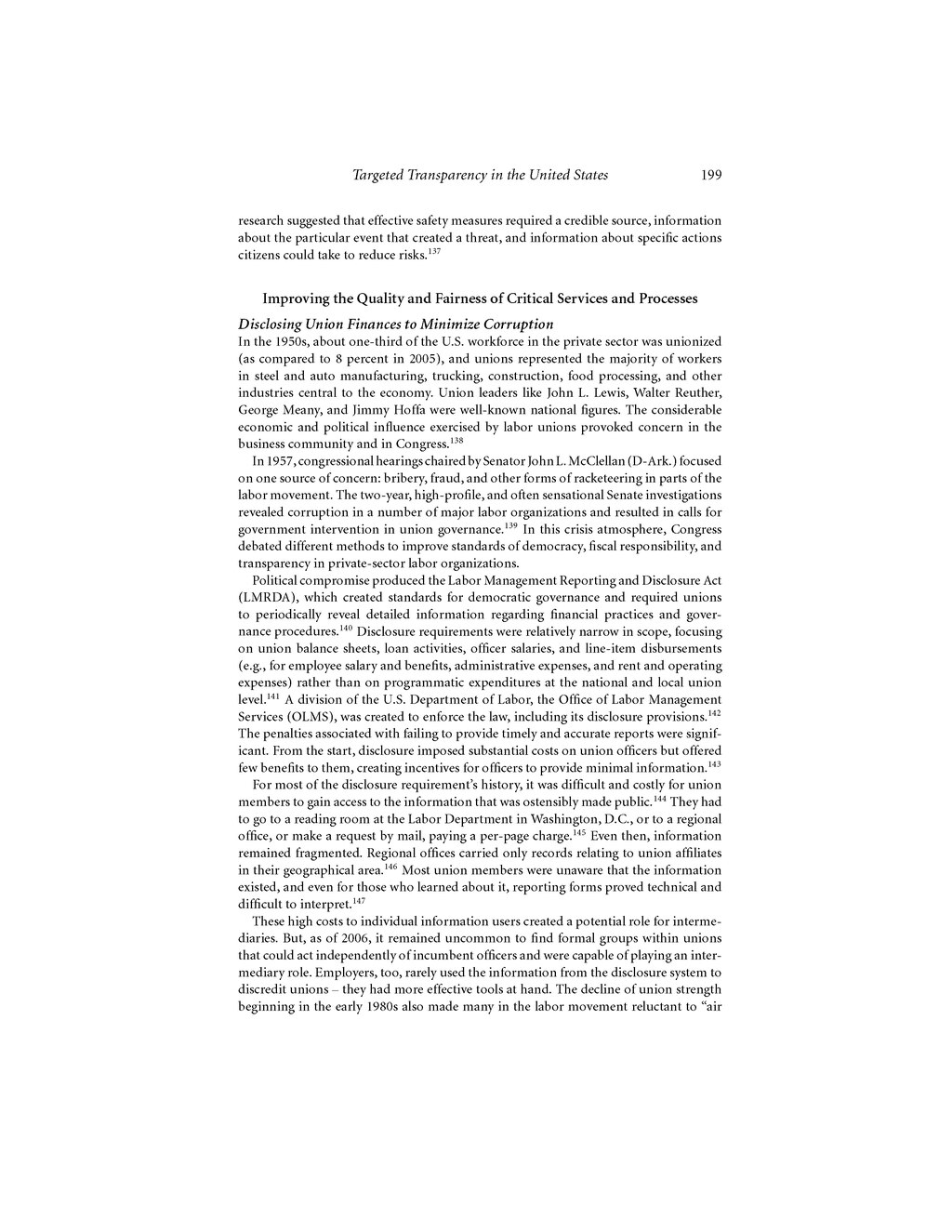research suggested that effective safety measures required a credible source, information about the particular event that created a threat, and information about specific actions citizens could take to reduce risks.[1]
Improving the Quality and Fairness of Critical Services and Processes
Disclosing Union Finances to Minimize Corruption
In the 1950s, about one-third of the U.S. workforce in the private sector was unionized (as compared to 8 percent in 2005), and unions represented the majority of workers in steel and auto manufacturing, trucking, construction, food processing, and other industries central to the economy. Union leaders like John L. Lewis, Walter Reuther, George Meany, and Jimmy Hoffa were well-known national figures. The considerable economic and political influence exercised by labor unions provoked concern in the business community and in Congress.[2]
In 1957, congressional hearings chaired by Senator John L. McClellan (D-Ark.) focused on one source of concern: bribery, fraud, and other forms of racketeering in parts of the labor movement. The two-year, high-profile, and often sensational Senate investigations revealed corruption in a number of major labor organizations and resulted in calls for government intervention in union governance.[3] In this crisis atmosphere, Congress debated different methods to improve standards of democracy, fiscal responsibility, and transparency in private-sector labor organizations.
Political compromise produced the Labor Management Reporting and Disclosure Act (LMRDA), which created standards for democratic governance and required unions to periodically reveal detailed information regarding financial practices and governance procedures.[4] Disclosure requirements were relatively narrow in scope, focusing on union balance sheets, loan activities, officer salaries, and line-item disbursements (e.g., for employee salary and benefits, administrative expenses, and rent and operating expenses) rather than on programmatic expenditures at the national and local union level.[5] A division of the U.S . Department of Labor, the Office of Labor Management Services (OLMS), was created to enforce the law, including its disclosure provisions.[6] The penalties associated with failing to provide timely and accurate reports were significant. From the start, disclosure imposed substantial costs on union officers but offered few benefits to them, creating incentives for officers to provide minimal information.[7]
For most of the disclosure requirement’s history, it was difficult and costly for union members to gain access to the information that was ostensibly made public.[8] They had to go to a reading room at the Labor Department in Washington, D.C., or to a regional office, or make a request by mail, paying a per-page charge.[9] Even then, information remained fragmented. Regional offices carried only records relating to union affiliates in their geographical area.[10] Most union members were unaware that the information existed, and even for those who learned about it, reporting forms proved technical and difficult to interpret.[11]
These high costs to individual information users created a potential role for intermediaries. But, as of 2006, it remained uncommon to find formal groups within unions that could act independently of incumbent officers and were capable of playing an intermediary role. Employers, too, rarely used the information from the disclosure system to discredit unions – they had more effective tools at hand. The decline of union strength beginning in the early 1980s also made many in the labor movement reluctant to “air
- ↑
- ↑
- ↑
- ↑
- ↑ Concern about the LMRDA violating union officers’ Fifth Amendment rights under the Constitution is discussed in Robb, 1961. A pessimistic view from the time concerning the prospects for improving internal union democracy through government intervention can be found in Petro, 1959.
- ↑
- ↑
- ↑
- ↑
- ↑
- ↑
